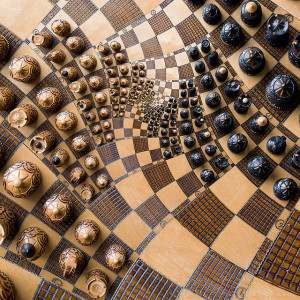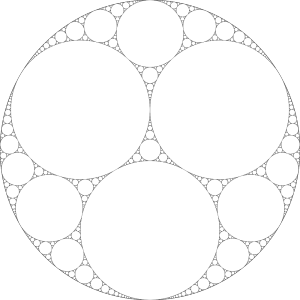
In set theory, the diamond principle asserts the existence of a sequence of objects $A_\alpha$, of growing size, such that any large object at the end is very often anticipated by these approximations. In the case of diamond on the ordinals, what we will have is a definable sequence of $A_\alpha\subseteq\alpha$, such that for any definable class of ordinals $A$ and any definable class club set $C$, there are ordinals $\theta\in C$ with $A\cap\theta=A_\theta$. This kind of principle typically allows one to undertake long constructions that will diagonalize against all the large objects, by considering and reacting to their approximations $A_\alpha$. Since every large object $A$ is often correctly approximated that way, this enables many such constructions to succeed.
Let me dive right in to the main part of the argument.$\newcommand\restrict\upharpoonright
\newcommand\of\subseteq
\newcommand\Ord{\text{Ord}}
\newcommand\HOD{\text{HOD}}\newcommand\ZFC{\text{ZFC}}$
Theorem. In $\ZFC$, if there is a definable well-ordering of the universe, then $\Diamond_{\Ord}$ holds for definable classes. That is, there is a $p$-definable sequence $\langle A_\alpha\mid\alpha<\Ord\rangle$, such that for any definable class $A\of\Ord$ and any definable closed unbounded class of ordinals $C\of\Ord$ (allowing parameters), there is some $\theta\in C$ with $A\cap\theta=A_\theta$.
Proof. The theorem is proved as a theorem scheme; namely, I shall provide a specific definition for the sequence $\vec A=\langle A_\alpha\mid\alpha<\Ord\rangle$, using the same parameter $p$ as the definition of the global well-order and with a definition of closely related syntactic complexity, and then prove as a scheme, a separate statement for each definable class $A\of\Ord$ and class club $C\of\Ord$, that there is some $\alpha\in C$ with $A\cap\alpha=A_\alpha$. The definitions of the classes $A$ and $C$ may involve parameters and have arbitrary complexity.
Let $\lhd$ be the definable well-ordering of the universe, definable by a specific formula using some parameter $p$. I define the $\Diamond_{\Ord}$-sequence $\vec A=\langle A_\alpha\mid\alpha<\Ord\rangle$ by transfinite recursion. Suppose that $\vec A\restrict\theta$ has been defined. I shall let $A_\theta=\emptyset$ unless $\theta$ is a $\beth$-fixed point above the rank of $p$ and there is a set $A\of\theta$ and a closed unbounded set $C\of\theta$, with both $A$ and $C$ definable in the structure $\langle V_\theta,\in\rangle$ (allowing parameters), such that $A\cap\alpha\neq A_\alpha$ for every $\alpha\in C$. In this case, I choose the least such pair $(A,C)$, minimizing first on the maximum of the logical complexities of the definitions of $A$ and of $C$, and then minimizing on the total length of the defining formulas of $A$ and $C$, and then minimizing on the Gödel codes of those formulas, and finally on the parameters used in the definitions, using the well-order $\lhd\restrict V_\theta$. For this minimal pair, let $A_\theta=A$. This completes the definition of the sequence $\vec A=\langle A_\alpha\mid\alpha\in\Ord\rangle$.
Let me remark on a subtle point, since the meta-mathematical issues loom large here. The definition of $\vec A$ is internal to the model, and at stage $\theta$ we ask about subsets of $\theta$ definable in $\langle V_\theta,\in\rangle$, using the truth predicate for this structure. If we were to run this definition inside an $\omega$-nonstandard model, it could happen that the minimal formula we get is nonstandard, and in this case, the set $A$ would not actually be definable by a standard formula. Also, even when $A$ is definable by a standard formula, it might be paired (with some constants), with a club set $C$ that is defined only by a nonstandard formula (and this is why we minimize on the maximum of the complexities of the definitions of $A$ and $C$ together). So one must give care in the main argument keeping straight the distinction between the meta-theoretic natural numbers and the internal natural numbers of the object theory $\ZFC$.
Let me now prove that the sequence $\vec A$ is indeed a $\Diamond_{\Ord}$-sequence for definable classes. The argument follows in spirit the classical proof of $\Diamond$ in $L$, subject to the mathematical issues I mentioned. If the sequence $\vec A$ is not a diamond sequence, then there is some definable class $A\of\Ord$, defined in $\langle V,\in\rangle$ by a specific formula $\varphi$ and parameter $z$, and definable club $C\of\Ord$, defined by some $\psi$ and parameter $y$, with $A\cap\alpha\neq A_\alpha$ for every $\alpha\in C$. We may assume without loss that these formulas are chosen so as to be minimal in the sense of the construction, so that the maximum of the complexities of $\varphi$ and $\psi$ are as small as possible, and the lengths of the formulas, and the Gödel codes and finally the parameters $z,y$ are $\lhd$-minimal, respectively, successively. Let $m$ be a sufficiently large natural number, larger than the complexity of the definitions of $\lhd$, $A$, $C$, and large enough so that the minimality condition we just discussed is expressible by a $\Sigma_m$ formula. Let $\theta$ be any $\Sigma_m$-correct ordinal above the ranks of the parameters used in the definitions. It follows that the restrictions $\lhd\restrict V_\theta$ and also $A\cap\theta$ and $C\cap\theta$ and $\vec A\restrict\theta$ are definable in $\langle V_\theta,\in\rangle$ by the same definitions and parameters as their counterparts in $V$, that $C\cap\theta$ is club in $\theta$, and that $A\cap\theta$ and $C\cap\theta$ form a minimal pair using those definitions with $A\cap\alpha\neq A_\alpha$ for any $\alpha\in C\cap\theta$. Thus, by the definition of $\vec A$, it follows that $A_\theta=A\cap\theta$. Since $C\cap\theta$ is unbounded in $\theta$ and $C$ is closed, it follows that $\theta\in C$, and so $A_\theta=A\cap\theta$ contradicts our assumption about $A$ and $C$. So there are no such counterexample classes, and thus $\vec A$ is a $\Diamond_{\Ord}$-sequence with respect to definable classes, as claimed.
QED
Theorem. The following are equivalent over $\ZFC$.
- There is a definable well-ordering of the universe, using some set parameter $p$.
- $V=\HOD_{\{p\}}$, for some set $p$.
- $\Diamond_{\Ord}$ holds for definable classes. That is, there is a set parameter $p$ and a definable sequence $\vec A=\langle A_\alpha\mid\alpha<\Ord\rangle$, such that for any definable class $A\of\Ord$ and definable class club $C\of\Ord$, there is some $\alpha\in C$ with $A\cap\alpha=A_\alpha$.
Proof. Let me first give the argument, and then afterward discuss some issues about the formalization, which involves some subtle issues.
($1\to 2$) $\newcommand\rank{\text{rank}}$Suppose that $\lhd$ is a $p$-definable well-ordering of $V$, which means that every set has a $\lhd$-minimal element. Let us refine this order by defining $x\lhd’ y$, just in case $\rank(x)<\rank(y)$ or $\rank(x)=\rank(y)$ and $x\lhd y$. The new order is also a well-order, which now respects rank. In particular, the order $\lhd’$ is set-like, and so every object $x$ is the $\alpha^{th}$ element with respect to the $\lhd’$-order, for some ordinal $\alpha$. Thus, every object is definable from $p$ and an ordinal, and so $V=\HOD_{\{p\}}$, as desired.
($2\to 1$) If $V=\HOD_{\{p\}}$, then we have the canonical well-order of $\HOD$ using parameter $p$, similar to how one shows that the axiom of choice holds in $\HOD$. Namely, define $x\lhd y$ if and only if $\rank(x)<\rank(y)$, or the ranks are the same, but $x$ is definable from $p$ and ordinal parameters in some $V_\theta$ with a smaller $\theta$ than $y$ is, or the ranks are the same and the $\theta$ is the same, but $x$ is definable in that $V_\theta$ by a formula with a smaller Gödel code, or with the same formula but smaller ordinal parameters. It is easy to see that this is a $p$-definable well-ordering of the universe.
($1\to 3$) This is the content of the theorem above.
($3\to 1$) If $\vec A$ is a $p$-definable $\Diamond_{\Ord}$-sequence for definable classes, then it is easy to see that if $A$ is a set of ordinals, then $A$ must arise as $A_\alpha$ for unboundedly many $\alpha$. In $\ZFC$, using the axiom of choice, it is a standard fact that every set is coded by a set of ordinals. So let us define that $x\lhd y$, just in case $x$ is coded by a set of ordinals that appears earlier on $\vec A$ than any set of ordinals coding $y$. This is clearly a well-ordering, since the map sending $x$ to the ordinal $\alpha$ for which $A_\alpha$ codes $x$ is an $\Ord$-ranking of $\lhd$. So there is a $p$-definable well-ordering of the universe.
QED
An observant reader will notice some meta-mathematical issues concerning the previous theorem. The issue is that statements 1 and 2 are known to be expressible by statements in the first-order language of set theory, as single statements, but for statement 3 we have previously expressed it only as a scheme of first-order statements. So how can they be equivalent? The answer is that the full scheme-theoretic content of statement 3 follows already from instances in which the complexity of the definitions of $A$ and $C$ are bounded. Basically, once one gets the global well-order, then one can construct a $\Diamond_{\Ord}$-sequence that works for all definable classes. In this sense, we may regard the diamond principle $\Diamond_{\Ord}$ for definable classes as not really a scheme of statements, but rather equivalent to a single first-order assertion.
Lastly, let me consider the content of the theorems in Gödel-Bernays set theory or Kelley-Morse set theory. Of course, we know that there can be models of these theories that do not have $\Diamond_{\Ord}$ in the full second-order sense. For example, it is relatively consistent with ZFC that an inaccessible cardinal $\kappa$ does not have $\Diamond_\kappa$, and in this case, the structure $\langle V_\kappa,\in,V_{\kappa+1}\rangle$ will satisfy GBC and even KM, but it won’t have $\Diamond_{\Ord}$ with respect to all classes, even though it has a definable well-ordering of the universe (since there is such a well-ordering in $V_{\kappa+1}$). But meanwhile, there will be a $\Diamond_{\Ord}$-sequence that works with respect to classes that are definable from that well-ordering and parameters, simply by following the construction given in the theorem.
This leads to several extremely interesting questions, about which I am currently thinking, concerning instances where we can have $\Diamond_\kappa$ for definable classes in $V_\kappa$, even when the full $\Diamond_\kappa$ fails. Stay tuned!



 I should like to give a brief account of the argument that KM implies Con(ZFC) and much more. This argument is well-known classically, but unfortunately seems not to be covered in several of the common set-theoretic texts.
I should like to give a brief account of the argument that KM implies Con(ZFC) and much more. This argument is well-known classically, but unfortunately seems not to be covered in several of the common set-theoretic texts.